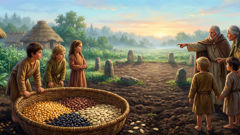Introduction
When the sun leaned low and the earth smelled of warm loam, elders would gather children in a circle of woven mats and braided hair, and they would tell the same story: the story of three sisters who could not live apart. It was not a tale of people alone, but of the land’s own family — tall, whispering Corn, twining Bean, and the wide, round Squash whose leaves held morning dew like bright coins. The Iroquois, like other peoples of these forests and river valleys, named them sisters because their lives were bound together, because each one carried a gift the others could not. Corn rose as a pillar, its ribbed stalks offering a scaffold. The Beans, hungry for the sky’s iron, wound themselves upward and gave nitrogen back into the soil, a quiet barter of breath and root. Squash spread low, its broad leaves shading the ground, slowing the sun’s hunger, keeping moisture trapped under a living quilt. Plant them together and they thrived; plant them alone and one or two might struggle. Generations trusted that the Three Sisters would teach them how to feed families and heal fields, how to sing to the seeds and listen to the land. In the space between story and practice, between myth and kitchen, the Three Sisters held a map of survival: a method of planting, a theology of reciprocity, and a reminder that life is best when shared. This is their story — braided with ritual, soil, song, and the patient wisdom of many hands.
Origin and Allegory: The Sisters Who Would Not Be Separated
Long before the land was written down in maps, the people who lived along these rivers and in these woodlands told stories that blurred the borders between human families and the larger families of nature. The Three Sisters tale exists in many forms — whispered as a blessing when seed was handed over, intoned as a recipe for planting and living, performed at festivals, taught in longhouses — but it always returns to the same center: a lesson in cooperative life. The oldest versions speak of three sisters who were born under the same birch and promised to remain together. One grew tall and hollow, a green column that caught wind and light; this was Corn, crowned in tassels and bearing kernels like strings of sunlight. Another was lean and quick to climb, her stems curling to meet the sky and braid themselves around any support; she was Bean, who delighted in climbing and in giving back to the earth with her secret chemistry. The third sister was round and generous, trailing low, her leaves broad and matte as river stones; she was Squash, who could shelter smaller creatures beneath her shadow and whose fruit held summer’s sweetness for winter’s tables.

In some tellings the sisters actually argued — Corn could not reach the world of touch without Bean’s embrace; Bean could not stand without Corn; Squash felt lonely until she was given the chance to spread and protect. An elder woman, a gardener and midwife, is sometimes the one who warns them: ‘Seed only can change the world if you refuse to be alone.’ So they agree to plant themselves together in a trio, and when the first season passes they learn to feed one another. The legend becomes a living law: plant Corn first as a pole, then tuck Beans at its roots to braid and lift. Let Squash spill at their feet to shade and shelter. The story encodes a usable ecology — the maize provides a trellis, the beans fix nitrogen and curb hunger in the soil, and the squash becomes a living mulch, shading weeds and guarding moisture.
But this is more than clever husbandry; it is an ethic of relationship. In telling the story, elders teach reciprocity: gifts must be returned and responsibilities shared. Corn is proud, but it cannot alone feed a winter family; Bean is generous but leans on others; Squash teaches humility through its spread. The sisters show that mutual dependence is not weakness but strength: together they form a complete meal and a sustainable field. The kernels, the pods, and the sweet curving fruit are also metaphors. They speak to cycles: to planting, to harvest, to preparation for cold months, to storytelling by firelight. Through imagery and ritual — songs that mimic the pulling of roots, dances that mimic climbing vines, offerings of tobacco and thanks at the first planting — people acknowledged that life depends on gratitude and balance.
Historic traces of these practices appear across regions where maize took hold in North America. While the name ‘Three Sisters’ is often used in English retellings, indigenous languages carry nuances: the sisters are sometimes described in kinship terms that reflect human social structures, sometimes in terms of seasonal labor. The effect is the same: a narrative that teaches a practical companion planting system while embedding it in cosmology. In harvest ceremonies, the three crops are honored together. Bread and stew made from cornmeal and beans cooked with squash are not mere comfort; they are embodiments of the sisters’ promise — nutrition, preservation, and community. When the story is told now, it travels between gardens and classrooms, between urban rooftop plots and remote reservations. It becomes a bridge connecting past knowledge with present needs, proving that old wisdom adapts. Modern gardeners who practice companion planting are likely to discover the same empirical truth the Iroquois and other indigenous peoples relied on: plants, like people, flourish in proper relationships.
As myth, the Three Sisters also carries warnings. Elders caution against greed and monoculture, telling how a village that planted only Corn found its fields exhausted and its people weak. The tale turns ecology into morality: land abused is land that will not return its gifts. Conversely, fields tended with respect proliferate. The personified sisters teach stewardship, and the tale insists that humans are part of a larger conversation. In quiet voice or in the bright laughter of children pulling up seedlings, the story instructs listeners to look beyond the individual, to plant in ways that honor the soil, the seeds, and the coming generations. Even the language of the story — verbs that suggest tending and listening, nouns that carry kinship — invites a different kind of agriculture, one built of patience, reciprocity, and ceremony.
At night, near the smoke of the longhouse, elders would often press kernels into young hands and say, ‘Remember the sisters when you feed your children; remember how they protect one another.’ In this way the Three Sisters became a living classroom, an oral archive of techniques and a moral compass. You feel this in the story’s texture: it is at once practical and poetic, offering rows to plant and reasons to care. To dig the first mound in spring is to step into a tale older than any map, to place your hands where generations placed theirs, and to feed both bodies and stories across seasons.
This legend, then, is not only a memory of how people once fed themselves; it is an enduring invitation to practice kinship with the land. Its imagery — the braided stalks, the curling tendrils, the quiet carpet of leaves — remains a vivid visual and a useful guide. Whether told by the Iroquois around a fire, by a teacher in a city garden, or by a farmer saving seed for the next spring, the sisters keep teaching: plant together, feed together, live together. The stories ripple outward, shaping ceremonies and kitchen tables, and in so doing they renew an ancient law of life: that survival is communal, and that the fullest harvest comes when we refuse to let the sisters be separated.
Practical Wisdom and Living Traditions: How the Sisters Teach Today
The story’s living instruction translates directly into practice: the technique known today as companion planting. To plant the Three Sisters, one clears a patch and forms small mounds of earth; each mound becomes an island of life. Corn kernels are placed in the center and, once they reach a certain height, beans are tucked near the base to climb. Squash seeds are sown around the edges, allowed to sprawl and shade the soil. This configuration conserves moisture, suppresses weeds, and reduces pests — a natural symbiosis that modern ecologists praise for its efficiency and resilience. Yet the wisdom embedded in this practice is not merely functional; it is cultural. Planting the Three Sisters is also an act of remembrance and continuity. When indigenous farmers and gardeners plant these crops together, they enact a story that binds community, land, and food.

Across generations, subtle variations occurred according to region and preference. Some people interplanted different varieties of corn — flint and flour types — to extend harvest uses. Beans varied from common pole beans to indigenous varieties with names that tell their histories. Squash included many types: the elongated necked squash for drying, round winter squash for storage, and summer varieties eaten fresh. Seeds were chosen not only for yield but for flavor, storability, and cultural resonance. Heirloom varieties, passed hand to hand, carry stories in their genetic memory: a bean named after a grandmother, a corn color that recalls a certain village, a squash whose shape suits ceremonial bowls. These choices made fields into living archives.
The sisters also shaped ritual calendars. Planting ceremonies might include songs that invoke rain or request protection from pests; offerings were sometimes placed in the soil to give thanks. When harvest came, rituals gave thanks again, and portions of the harvest were set aside for guests, for elders, and for offerings to spirits. The culinary side of the Three Sisters is as creative as it is sustaining. Corn ground into meal becomes a base for breads and porridge; beans add protein and texture, and squash adds vitamins, storage capacity, and culinary variety. The three together form a nutritionally complementary triad — carbohydrates, protein, and vitamins — which sustained families through harsh winters and lean seasons. This practical completeness underlies why the sisters were valued so highly.
In the modern era, as monoculture and industrial agriculture spread, the Three Sisters reminder becomes urgent. Fields planted with a single crop are more vulnerable to pests, disease, and market swings. By contrast, diversified plantings — implicit in the Three Sisters method — foster resilience. Many contemporary gardeners, permaculturists, and indigenous food sovereignty initiatives turn to the sisters as both inspiration and guide. Urban community gardens splash raised beds with corn, beans, and squash, and in doing so they also revive traditions of sharing and teaching: elders are invited to speak, youth learn hand to hand, and stories are retold as living practice. Seed-saving circles bring elders and scientists into conversation; the seeds are not mere commodities but carriers of culture and adaptation.
The Three Sisters also call attention to relationships between people and nonhuman relatives. As climate changes alter growing seasons and water patterns, planting practices that respect soil health and biodiversity become increasingly valuable. Intercropping and living mulches — ideas embedded in the Three Sisters — are techniques that reduce erosion, build organic matter, and attract beneficial insects. Researchers find that mixed plantings can lower the need for synthetic fertilizers, thereby reducing runoff and improving long-term soil function. Indigenous farmers and community gardeners often blend ancestral knowledge with contemporary ecological science, thereby co-creating solutions rooted in both history and innovation. The sisters thus act as a nexus where ancestral stories, sustainable agriculture, and community resilience intersect.
Cultural revitalization also flows from the sisters. Festivals celebrating the harvest bring people together to make succotash and hominy, braids of dried corn hang as color and memory, and young people learn not only to grow food but to honor the seeds that have sustained their families. In some communities, schools integrate the story into curriculum, teaching both the tale and the technique so children understand the ethical as well as the practical dimensions of agriculture. The sisters become a tool for identity, for reclaiming traditions disrupted by colonization, and for reconnecting to land rights and food sovereignty. They offer a framework for communities seeking to rebuild local food systems and to protect indigenous seed lines from commercial erosion.
At the same time, telling the story sensitively matters. The Three Sisters belong to living peoples and living cultures; sharing the tale requires respect for its origins and for the people who carry it. Many indigenous teachers ask that retellings acknowledge provenance and that planting practices be used as entry points for learning broader histories and responsibilities. The story becomes a relational doorway: once you plant the sisters, you are invited to learn more — about ceremonies, about language, about the ways a culture integrates ecology and ethics.
Finally, the household benefits of planting the Three Sisters are immediate and human. Imagine an early morning in late summer: dew on broad squash leaves, beans looping like dancers around corn, and the corn tassels moving soft as a choir. Harvest brings hands sticky with sap, laughter at the sight of a surprise squash tucked under leaves, and the warm comfort of meals that sustain both body and story. When the family mills corn into meal, cooks beans with savory broth, and roasts squash for winter, they are doing more than preparing food — they are keeping a cycle of care alive. That cycle is both pragmatic and sacred: the sisters provide nourishment, yes, but they also shape how people move through seasons, how they greet visitors, how they remember ancestors. To plant the Three Sisters is to accept a small contract with the future: you will tend, and the field will return with abundance. It is a pact of reciprocity, a lesson in humility, and an affirmation that life flourishes in companionship, whether among plants, people, or ideas.
Conclusion
The story of the Three Sisters endures because it marries myth to practicality, because its imagery and technique solve human needs while shaping a way of life. Corn, Beans, and Squash are more than crops; they are relatives in an agricultural household that teaches reciprocity, resilience, and humility. Planting them together is an act of ecological intelligence: a living testament that diversity nourishes, that relationships sustain, and that cultural memory can guide modern practice. Where modern agriculture often forgets relationship, the Three Sisters remember it: the soil remembers hands that tended it, the seeds remember hands that saved them, and people remember stories that teach them to live with care. To tell and to plant the Three Sisters is to choose a lineage of generosity, to practice stewardship that honors the past, and to invest gently and wisely in the future. As long as people gather around gardens and stoke cooking fires, the sisters will continue to teach — not only how to feed a family, but how to hold a promise to the land and to one another.













